Harvesting Italian genealogy records
I call it harvesting, not researching, because the records are all readily available. It is about as challenging as hunting for dairy cows in a pasture.

When viewing a record on FamilySearch, you will need to enlarge it. The arrow points to a plus sign. Click that to enlarge the image. You can click your mouse on the image and, holding the mouse button down, drag your mouse to drag the image so the part you want to see is revealed.

 | Click on Adjust Image |
 | Click on the controls under Brightness and Contrast, and, holding your mouse button down, drag your mouse to the left or right to slide the control to the desired setting. Remember, this works for FamilySearch and not for the Antenati website. |
Harvesting a marriage record
Start with lined paper. Stock up on the low-priced notebooks at the department store during back-to-school sales. Using one page per record is really the most efficient, because your eyes will focus on the record you are doing.
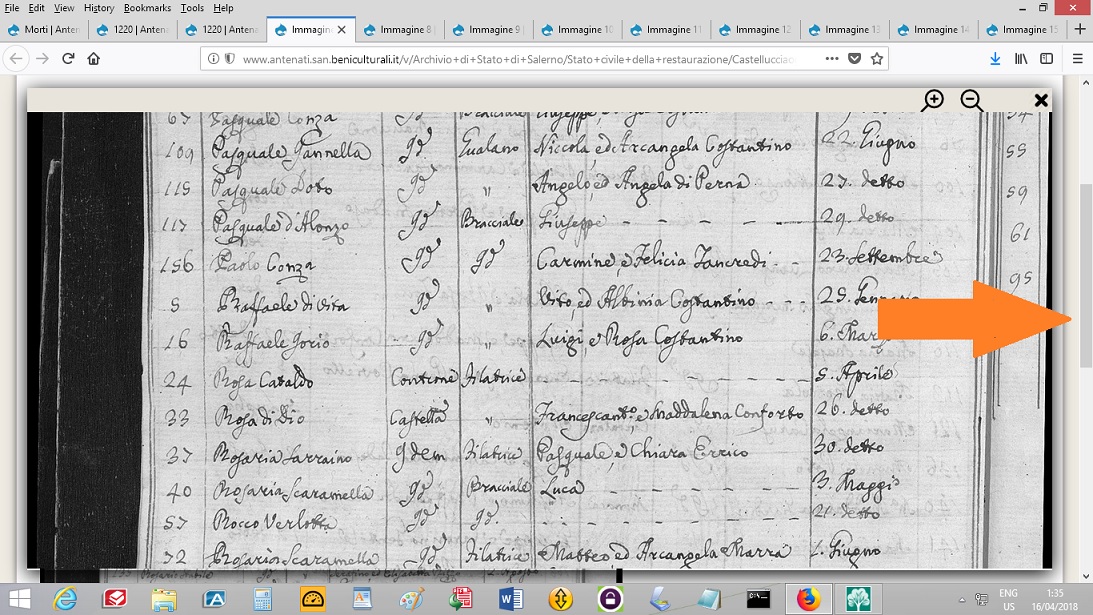
If your browser won’t let you drag an image from the Antenati site, click on the scroll bar on the right and hold your mouse button down while you drag the mouse up or down to move the scroll bar. This gives you more room to move the image in your browser.
I would start with the marriage records because this builds the framework connecting multiple generations, and you can add the births and deaths to that framework.
The marriage record in this example is from Castelluccia, Principato Citeriore, which today is Castelcivita, Salerno. It is found at http://www.antenati.san.beniculturali.it/v/Archivio+di+Stato+di+Salerno/Stato+civile+della+restaurazione/Castellucciaoggi+Castelcivita/Matrimoni/1843/1232/007346452_00069.jpg.html
When viewing a record on that site, click on the image to download and view the enlargement, which you can then enlarge even further as necessary.
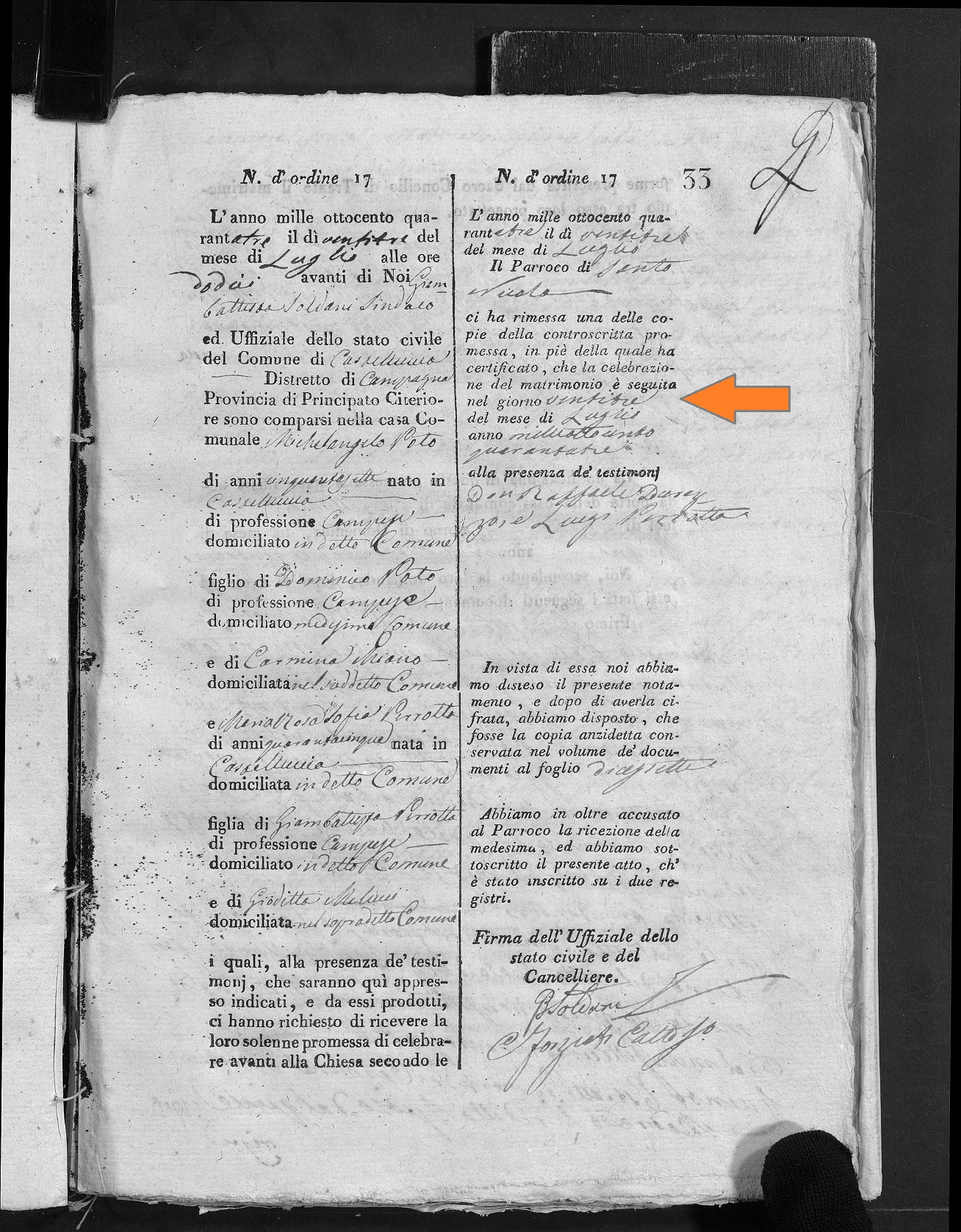
This record starts with the record number, N. d’ordine 17. This must be recorded because it says which record can be checked later to confirm information.
The first paragraph says that in the year one thousand eight hundred forty-three, the day twenty-three of the month of July at the hour twelve, before “us,” Giambattista Soldani, Mayor and official of the civil records of the Comune of Castelluccia, District of Campagna, Province of Principato Citeriore, are personally appeared in the town hall Michelangelo Poto of years fifty-seven, of profession Campese (as best I can tell) domiciled in the said comune, son of Domenico Poto of profession Campese, domiciled in the same comune, and of Carmina Miano, domiciled in the aforesaid comune and Maria Rosa Sofia Perrotta of years forty-five born in Castelluccia, domiciled in the said comune, daughter of Giambattista Perrotta of profession Campese, domiciled in the said comune, and of Gioditta Melucci domiciled in the aforesaid Comune and who, in the presence of witnesses...
You will need to harvest the names. Since the left column ends with solenne promessa di celebrare avanti alla Chiesa ... the marriage did not take place in the town hall. The arrow points to the spot in the marriage notation provided by the Parish of Santo Nicola, saying the marriage followed on day twenty-three of the month of July, year one thousand eight hundred forty-three and this is where you search for the date of marriage. In this case the dates are the same, but in some cases the wedding takes place on a later date. As for the solemn promise, I sometimes record this also, in RootsMagic under Marriage License because it is the category that best fits.
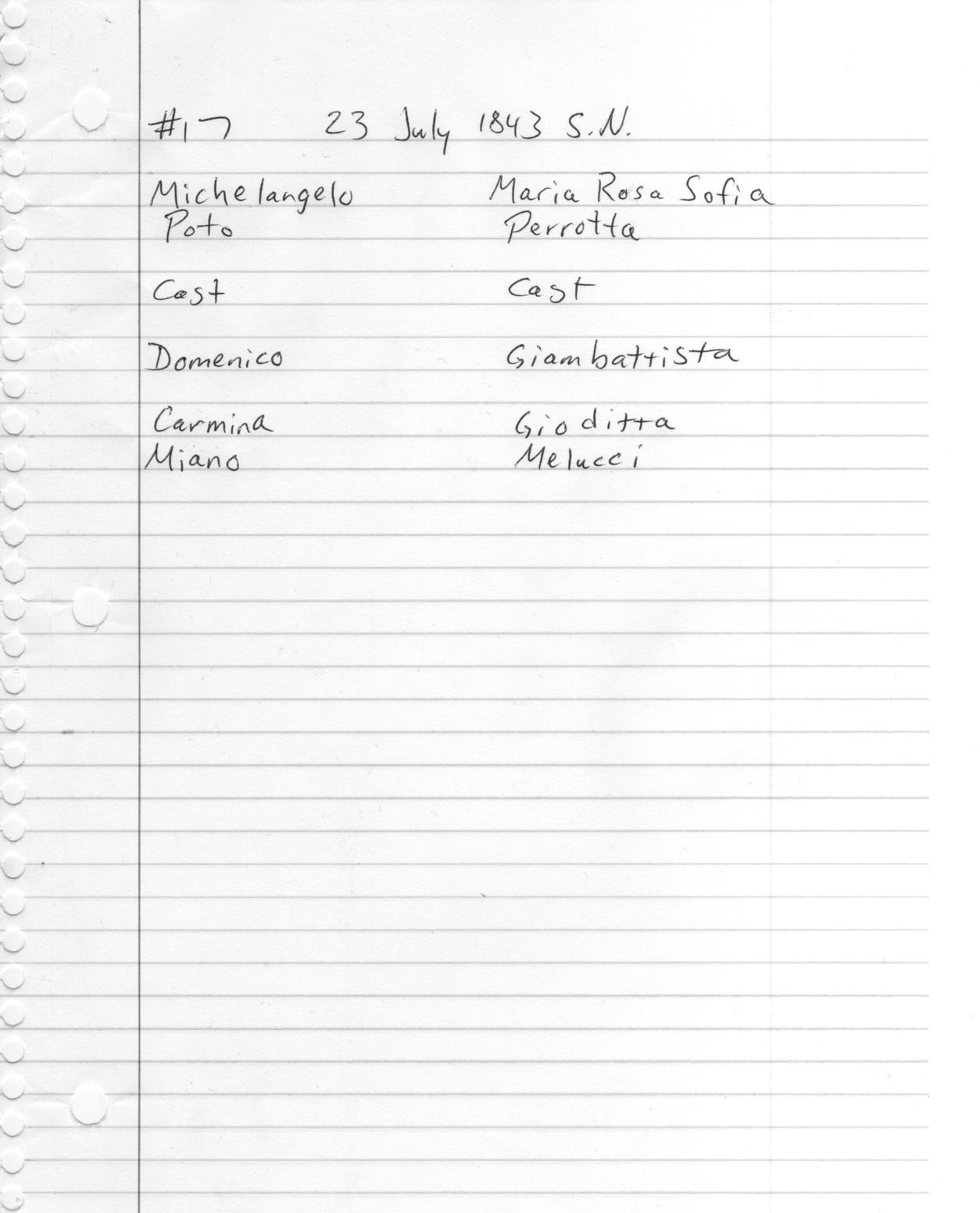
Use scrap paper like this to record the details from the first page of the marriage record. The first line gives the record number, the date of the marriage, and the initials of the church, which is necessary because Castelluccia had another church, Santo Cono. Next, go to the next page of the marriage record.
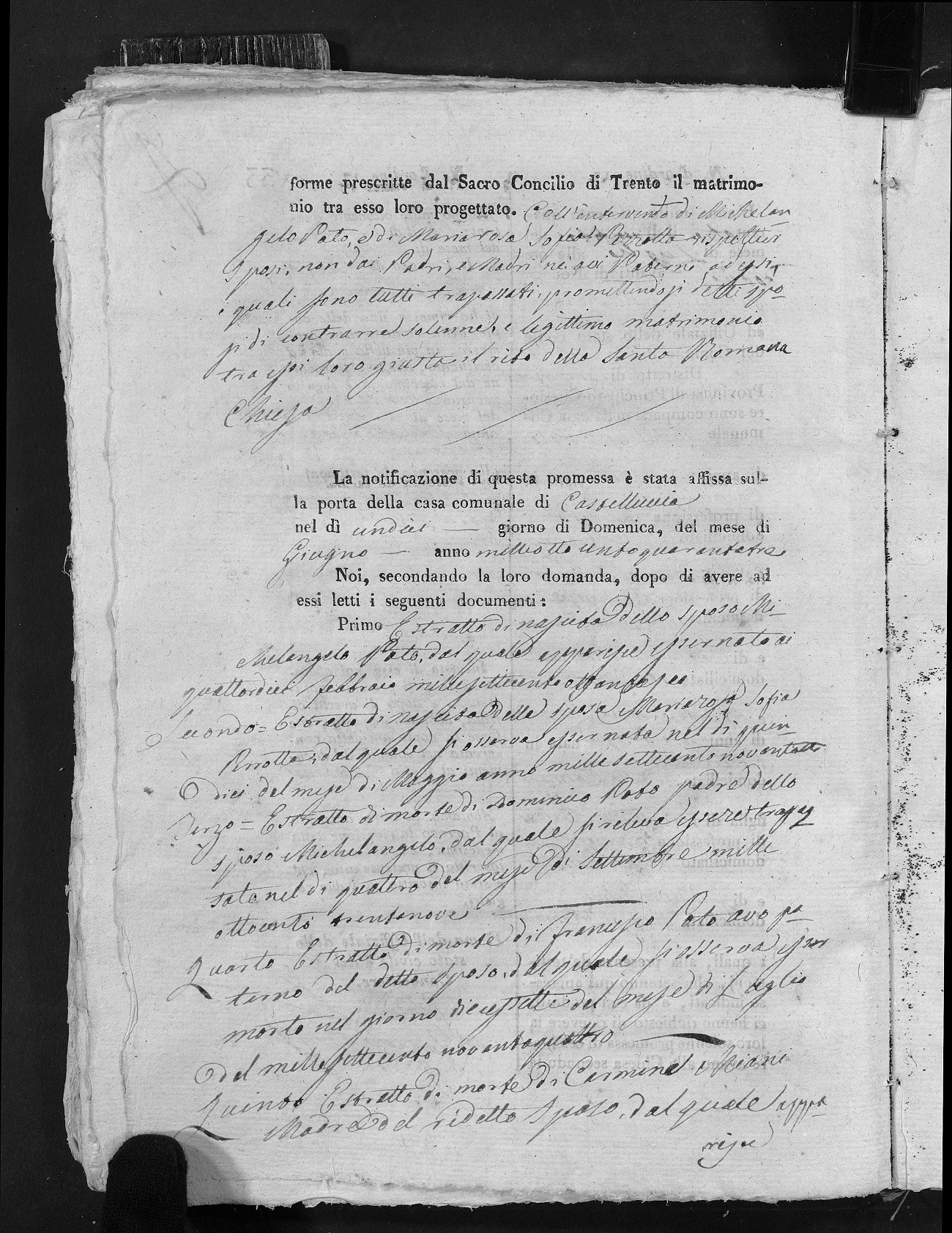
The opening line continues what is in the left column of the first page of the marriage record. You may be able to understand where it speaks of the form prescribed by the Sacred Council of Trent. The text goes on to allege that the notification of this promise has been affixed to the door of the town hall on the day eleven, Sunday, of the month of June, year one thousand eight hundred forty-three.
The document then says that “we,” at their request, after having read the following documents...
Here is a treasure trove of information, but remember that these are not primary records. In some cases the wrong death record may be found and unwittingly submitted instead of the correct one, the groom or bride having no more knowledge than you and I about his or her grandfather’s death. It could be the record of another man with the same name. Also, humans make mistakes and in some cases the date of one event could be written as the date of another event.
Primo The extract of the birth of the groom, Michelangelo Poto, from which he appears to be born the day fourteen February one thousand seven hundred eighty-six.
This is precious because the records available on line do not start that early.
Second, extract of the birth of the bride, Mariarosa Sofia Perrotta, from which is observed to be born the day fifteen of the month of May year one thousand seven hundred ninety-eight.
Third, Extract of death of Domenico Poto, father of the groom Michelangelo Poto, from which is revealed to to be expired the day four of the month of September one thousand eight hundred thirty-nine.
The groom and bride needed the consent of their respective parents in order to marry, except when a parent was deceased. If the father was deceased, the consent of the paternal grandfather was required unless he, too was deceased. In such cases, proof of death was required, but sometimes a sworn statement was used in lieu of an extract.
Fourth, Extract of death of Francesco Poto, paternal grandfather of the groom, from which is observed to be dead the day seventeen of the month of July of one thousand seven hundred ninety-four.
Fifth, Extract of death of Carmina Miani, mother of the groom, from which appears to have passed to the better life the day twenty-five January one thousand eight hundred twenty-six.
Note how she was Carmina Miano on the first page and she is Carmina Miani here. Different spellings of the same name are quite common. I have also seen Caterina and Margarita spelled different ways.
Sixth, Extract of death of Antonia Cascio, first wife of the groom, from which is revealed to be dead on day seventeen of the month of April of one thousand eight hundred forty-two.
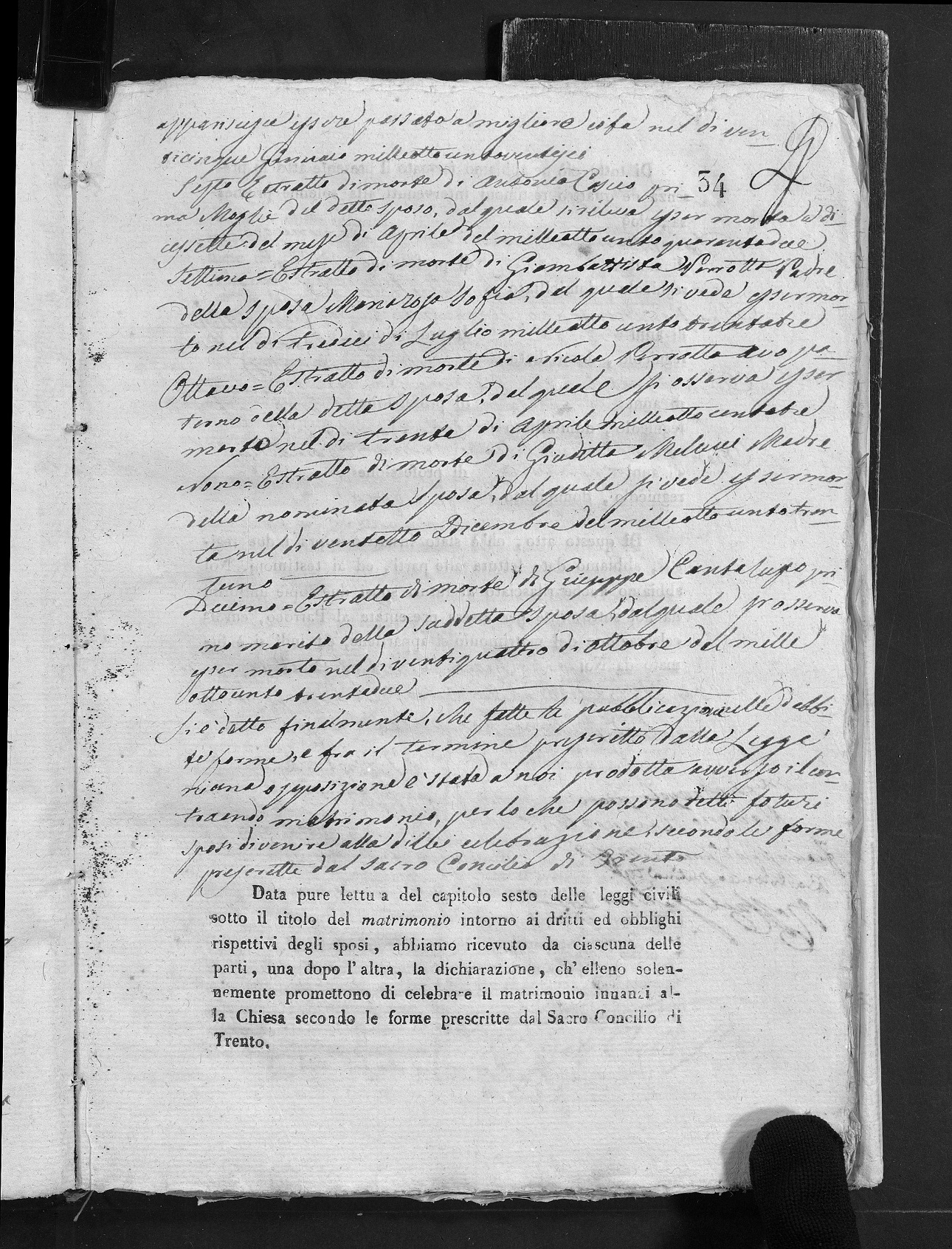
Seventh, Extract of the death of Giambattista Perrotta, father of the bride Marisarosa Sofia, from which is seen to be dead on the day thirteen of July one thousand eight hundred thirty-three.
Eighth, extract of death of Nicola Perrotta, paternal grandfather of the bride, from which is observed to be dead on the day thirty of April one thousand eight hundred three.
Ninth, Extract of death of Giuditta Melucci, mother of the wife nominee, from which is seen to be dead on the day twenty-eight December of one thousand eight hundred thirty-one.
Tenth, Extract of death of Giuseppe Cantalupo, first husband of the aforesaid bride, from which is observed to be dead on the day twenty-four of October of one thusand eight hundred thirty-two.
Finally, it goes on to include publication certificates in the form and terms prescribed by law. Yet this goes on to mention solennemente promettono di celebrare il matrimonio innanzi alla Chiesa secondo le forme prescritte dal Sacro Concilio di Trento (solemnly promising to celebrate the matrimony going forward in the Church following the form prescribed of the Sacred Council of Trent.)
Note: Many marriage records of this type list the documents but do not mention the dates. If the processetti are available you can check those. If your ancestral town’s records do include the dates, consider yourself fortunate and also lucky.

Here is the scrap paper with the added information. You are now ready to add the information to RootsMagic 7 or FamilySearch.
Maximize accuracy
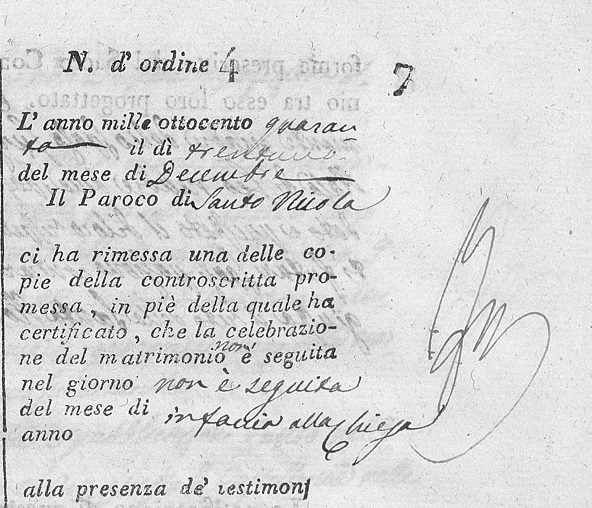 Watch out for everything. This record says that the marriage was not followed through in the face of the church. Even so, it provides considerable genealogy information.
Watch out for everything. This record says that the marriage was not followed through in the face of the church. Even so, it provides considerable genealogy information.http://www.antenati.san.beniculturali.it/v/Archivio+di+Stato+di+Salerno/Stato+civile+della+restaurazione/Castellucciaoggi+Castelcivita/Matrimoni/1840/1231/007348920_00017.jpg.html
Do not work too fast. Watch out for similar words such as Gennaro and Germano which look very much the same in some handwritings. Don’t misread milleottocentoquaranta as milleottocentocinquanta especially when the former is continued on the next line of writing. If you cannot confidently read a name, look for the same name elsewhere in the record. Remember that Don and Donna are titles of respect and not names.
Don’t record the bride as the groom’s mother. This is a self-correcting error because it quickly becomes obvious that you are missing somebody.
Start with the most recent records and work your way back. These have handwritings that are similar to today’s styles. You will increase your familiarity with the names, and that will make it easier to read the less-legible ones.
If you are compiling the records of the whole town, start with the marriage records because these connect the generations by naming the parents of the bride and groom.
Do not assume that you found the correct ancestral town merely because you found a family with the same names. There may be other families with the same names in other towns. On 13 February 1873, Rosario Cantalupo married Rosaria Gigliello in Castelcivita.
http://www.antenati.san.beniculturali.it/v/Archivio+di+Stato+di+Salerno/Stato+civile+italiano/Castelcivita/Matrimoni/1873/824/101279425_00010.jpg.html ... and on 21 February 1892 another Rosario Cantalupo married another Rosaria Gigliello in Castelcivita.
http://www.antenati.san.beniculturali.it/v/Archivio+di+Stato+di+Salerno/Stato+civile+italiano/Castelcivita/Matrimoni/1892/833/101279436_00009.jpg.html.
Imagine how many more such couples there might be in Italian records. Require a date of birth that matches exactly.